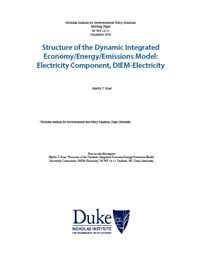This paper, a companion to NI WP 14-12, describes the structure of, and data sources for, the electricity component of the Dynamic Integrated Economy/Energy/Emissions Model (DIEM), which was developed at the Nicholas Institute for Environmental Policy Solutions at Duke University. The DIEM model includes a macroeconomic, or computable general equilibrium (CGE), component and an electricity component that gives a detailed representation of U.S. regional electricity markets. The electricity model (DIEM-Electricity) discussed in thus paper can be run as a stand-alone model or can be linked to the DIEM-CGE macroeconomic model to incorporate feedbacks among economy-wide energy policies and electricity generation decisions and interactions between electricity-sector policies and the rest of the U.S and global economies. Broadly, DIEM-Electricity is a dynamic linear-programming model of U.S. wholesale electricity markets that represents intermediate- to long-run decisions about generation, capacity planning, and dispatch of units. It provides results for generation, capacity, investment, and retirement by type of plant. It also determines wholesale electricity prices, production costs, fuel use, and CO2 emissions. Currently, the model can consider, at a national policy level, renewable portfolio standards, clean energy standards, caps on electricity-sector CO2 emissions, and carbon taxes.
Nicholas Institute for Environmental Policy Solutions
Publisher

